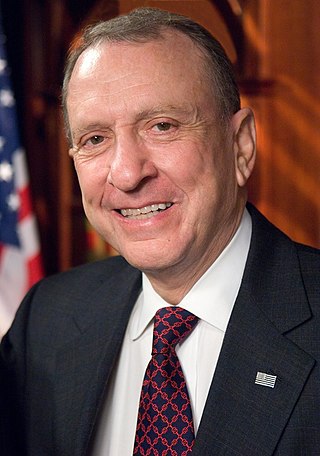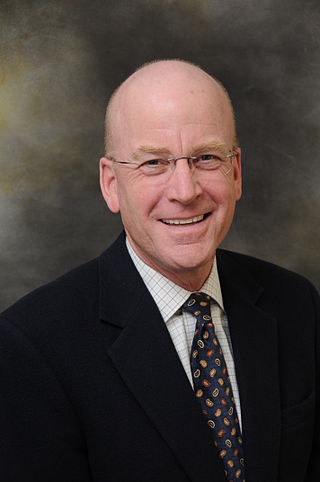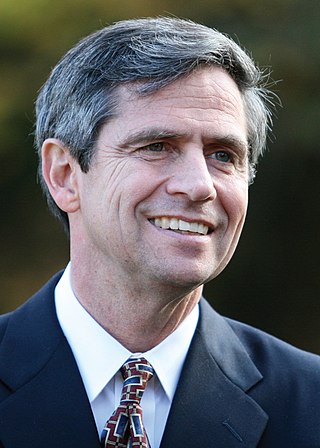
Arlen Specter was an American lawyer, author and politician who served as a United States Senator from Pennsylvania from 1981 to 2011. Specter was a Democrat from 1951 to 1965, then a Republican from 1965 until 2009, when he switched back to the Democratic Party. First elected in 1980, he was the longest-serving senator from Pennsylvania, having represented the state for 30 years.

Joseph Merrill Hoeffel III is an American author and politician. A Democrat, Hoeffel was a member of the United States House of Representatives from 1999 to 2005, representing Pennsylvania's 13th congressional district. He also served multiple terms on the Montgomery County Board of Commissioners, and from 1977–84, was a member of the Pennsylvania House of Representatives. A native of Philadelphia, he is a graduate of Boston University and Temple University School of Law.

The 2006 Pennsylvania gubernatorial election was held on November 7, 2006, and included the races for the governor of Pennsylvania and lieutenant governor of Pennsylvania. Incumbent Democratic governor Ed Rendell successfully ran for re-election. Pennsylvania's first female lieutenant governor, Catherine Baker Knoll, was also running for re-election.

The 2006 United States Senate election in Pennsylvania was held on November 7, 2006. Incumbent Republican Rick Santorum ran for re-election to a third term, but was defeated by Democratic State Treasurer Bob Casey, Jr., the son of former Pennsylvania governor Bob Casey Sr. Casey was elected to serve between January 3, 2007, and January 3, 2013.

Joseph Ambrose Sestak Jr. is an American politician and retired U.S. Navy officer. He represented Pennsylvania's 7th congressional district in the U.S. House of Representatives from 2007 to 2011 and was the Democratic nominee for the United States Senate in 2010. A three-star admiral, he was the highest-ranking military official ever elected to the United States Congress at the time of his election. He was a candidate for the Democratic presidential nomination in the 2020 election, launching his campaign on June 23, 2019 and ending it on December 1, 2019, subsequently endorsing Amy Klobuchar.
The Pennsylvania Republican Party (PAGOP) is the state affiliate of the Republican Party in Pennsylvania. It is headquartered in Harrisburg. Its chair is Lawrence Tabas and is the second largest political party in the state behind the Pennsylvania Democratic Party.

The 2010 Pennsylvania gubernatorial election was held on November 2, 2010, to elect the Governor and Lieutenant Governor of Pennsylvania, concurrently with elections to the United States Senate in Pennsylvania and other states and elections to the United States House of Representatives and various state and local elections.
This article lists statewide public opinion polls conducted relating to the 2008 Republican Party presidential primaries, typically using standard statistical methodology.
The Pennsylvania Democratic Party is the affiliate of the Democratic Party in the U.S. state of Pennsylvania. It is headquartered in Harrisburg and is the largest political party in the state. Its chair is Senator Sharif Street.

Pennsylvania is generally considered a swing state that leans slightly left. Throughout its entire history, it voted for the nationwide loser on only 10 occasions, meaning it has voted for the national winner 83% of the time as of 2020. Although, it generally supported Republicans between the Civil War and New Deal eras, as it voted Republican in every election between 1860 and 1932, except for 1912, when the Republican vote was split. Even then, the state's strong Republican ties meant that it backed Republican-turned-Progressive Theodore Roosevelt. The state backed a Democrat in 1936 for the first time since 1856. Pennsylvania generally leaned Democratic since the 1990s, as it backed the Democratic presidential candidate in every election since 1992 except in 2016, when it was won by Republican candidate Donald Trump with a plurality.

The 2010 United States Senate election in Pennsylvania took place on November 2, 2010, during the 2010 midterm elections. Incumbent Republican-turned-Democrat U.S. Senator Arlen Specter ran for reelection to a sixth term, but lost in the Democratic primary to Joe Sestak. Republican nominee Pat Toomey then won the seat.

Electoral history of Arlen Specter, former United States Senator from Pennsylvania (1981–2011), Chairman of the Senate Committees on Intelligence (1995–1997), Veterans' Affairs and Judiciary (2005–2007), as well as a candidate for the 1996 Republican presidential nomination.

The 1998 United States Senate election in Pennsylvania was held November 3, 1998. Incumbent Republican U.S. Senator Arlen Specter won re-election to a fourth term.

The 1992 United States Senate election in Pennsylvania was held on November 3, 1992. Incumbent Republican U.S. Senator Arlen Specter narrowly won re-election to a third term, garnering just forty-nine percent of the vote in what was described by The Philadelphia Inquirer as a "massive turnout for Bill Clinton."

The 1986 United States Senate election in Pennsylvania was held on November 4, 1986. Incumbent Republican U.S. Senator Arlen Specter won re-election to a second term.

The 1980 United States Senate election in Pennsylvania was held on November 4, 1980. Incumbent Republican U.S. Senator Richard Schweiker decided to retire, instead of seeking a third term.

The Democratic Party primary for the 2010 United States Senate election in Pennsylvania took place on May 18, 2010, when Congressman Joe Sestak defeated incumbent Arlen Specter, which led to the end of Specter's five-term Senatorial career. Just before the start of the primary campaign, after serving in the Senate as a Republican for 29 years, Specter had switched to the Democratic Party in anticipation of a difficult primary challenge by Pat Toomey; Toomey ultimately defeated Sestak in the general election. Political observers and journalists described the race between Specter and Sestak as one of the bitterest and most-watched of all the 2010 primary elections.

The 2016 United States Senate election in Pennsylvania took place on November 8, 2016, to elect a member of the United States Senate to represent the Commonwealth of Pennsylvania, concurrently with the 2016 U.S. presidential election, as well as other elections to the United States Senate in numerous other states and elections to the United States House of Representatives and various state and local elections. The primaries were held on April 26. Incumbent Republican U.S. Senator Pat Toomey was reelected to a second term in a close race, defeating Democratic nominee Katie McGinty and Libertarian Party nominee Edward Clifford. With a margin of 1.43%, this election was the second-closest race of the 2016 Senate election cycle, behind only the election in New Hampshire.

The 2016 Pennsylvania Democratic presidential primary was held on April 26 in the U.S. state of Pennsylvania as one of the Democratic Party's primaries ahead of the 2016 presidential election.

The 2020 United States presidential election in Pennsylvania was held on Tuesday, November 3, 2020, as part of the 2020 United States presidential election in which all 50 states plus the District of Columbia participated. Pennsylvania voters chose electors to represent them in the Electoral College via a popular vote, pitting the Republican Party's nominee, President Donald Trump, and running mate Vice President Mike Pence against Democratic Party nominee, former Vice President Joe Biden, and his running mate California Senator Kamala Harris. Pennsylvania had 20 electoral votes in the Electoral College.





















